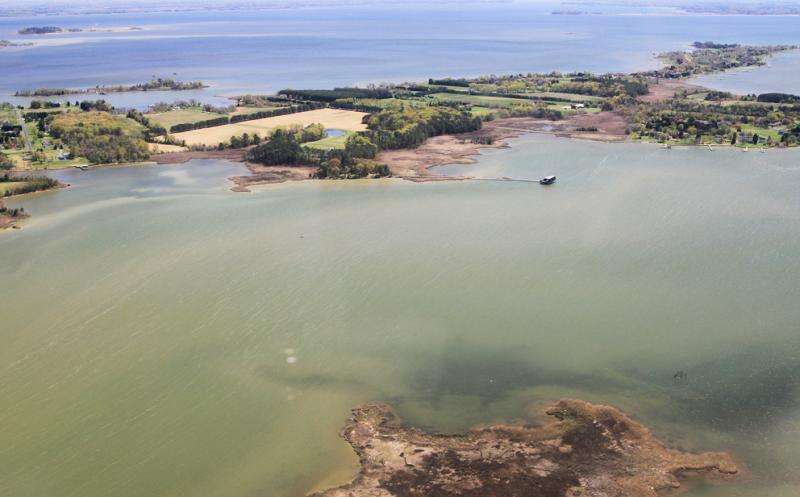Work begins to establish a baseline carbon budget for U.S. coastlines

Determining whether estuaries and tidal wetlands are net emitters or absorbers of carbon dioxide is the object of a NASA-funded study by a national team of researchers. The three-year, $1.2-million study, led by Penn State professor of oceanography Raymond Najjar, is the first to look at the entire contiguous U.S. estuarine and tidal-wetland system, and the team will establish a long-term, baseline carbon budget over the past several decades—the period for which most coastal carbon data have been collected.
The Wetland-Estuary Transports and CARbon Budgets (WETCARB) study encompasses 139 of the estuarine-wetland systems delineated and catalogued by the National Oceanic and Atmospheric Administration (NOAA), which account for more than 90 percent of estuarine surface area within the contiguous United States.
The focus is on coastal waters because of their role in absorbing carbon dioxide from the atmosphere explained Maria Herrmann, research associate at Penn State and WETCARB team member.
"Of the 10 billion tons of carbon that are released into the atmosphere each year by human activity, only about half stay there. Terrestrial and marine ecosystems provide us an invaluable service by sequestering the other half of the anthropogenic emissions."
While the open ocean has long been established as a key component in the global carbon budget and the regulation of atmospheric CO2, the coastal zone is understudied by comparison.
"Coastal waters have received much less attention because of their small area and unfortunate location on the divide between the terrestrial and oceanic study domains—but coastal ecosystems are extremely productive, with very high rates of photosynthesis and carbon burial, which makes them significant globally," Najjar said.
WETCARB will utilize remote sensing data gathered from NASA's fleet of satellites, including MODIS, SeaWiFS, MERIS, and Landsat, to investigate the environmental conditions controlling various aspects of the carbon budget, which includes input from rivers, exchange with the atmosphere and open ocean, burial, photosynthesis, and respiration.
"Coastal regions are so variable that it's not possible to figure out the carbon budget with only ground-based measurements. Remote sensing allows us to extrapolate the limited direct observations of carbon concentrations and fluxes," Najjar said. The remote sensing data being analyzed, which goes back to the 1990s, is a record of the wavelengths of light reflected off tidal wetlands and the surfaces of estuaries. These color images can be used to determine how much chlorophyll is present in the phytoplankton of estuaries and the leaves of tidal wetlands, which is related to how much CO2 these plants assimilate through photosynthesis.
Remote sensing expert and WETCARB team member Maria Tzortziou, associate professor, The City College of New York, said that monitoring estuarine carbon dynamics from space remains a major challenge. "This is mainly because of the complex composition of nearshore waters as well as the interference of a typically highly polluted atmosphere. We will be addressing some of these challenges by better characterizing the relationships between the carbon content and optical properties of estuarine waters and by developing improved remote sensing tools."
Jose Fuentes, professor of meteorology at Penn State and WETCARB team member, said that the satellite data will be integrated with data sets obtained at single sites. "Several seasons of data will be considered in the analyses to indicate when the ecosystems are sources or sinks of carbon. Also, long-term analyses are necessary to discern whether the carbon sequestration capability by coastal ecosystems is changing in response to environmental change, such as water-management practices and sea-level rise," said Fuentes.
In addition to establishing carbon fluxes in the 139 estuaries included in the study, the research aims to identify which estuaries have the highest potential for "blue carbon" projects, which are geared toward utilizing coastal vegetation to sequester atmospheric CO2.
"Coastal ecosystems around the world are highly stressed due to environmental change," Fuentes said. "But coastal ecosystems can be resilient. For example, tidal wetlands can cope with sea-level rise by migrating vertically by sediment accretion or horizontally by moving inland. However, this migration is being limited by increasing rates of sea-level rise and human development of the landscape, which means that some of the benefits of carbon sequestration by coastal ecosystems may be lost."
Najjar added that "the goal of WETCARB is to quantify the baseline carbon budget so that we are in a better position to quantify change and develop strategies to preserve the carbon sequestration capacity."
Provided by Pennsylvania State University



















